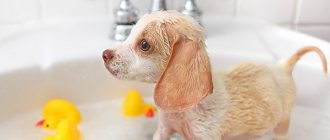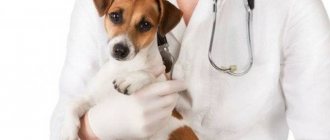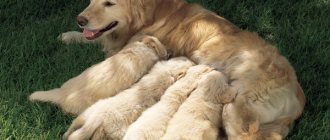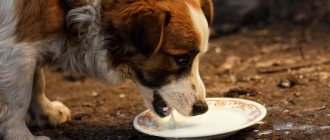Huskies are hardy dogs with good health. If you take proper care of your pet, it can live up to 20-25 years. However, many owners do not follow the rules of care, which is why the husky begins to feel sad and has health problems. For example, some dog breeders forget that this breed was bred to ride sleds. Therefore, regular physical activity is an essential part of a husky's life. Being locked up all day long makes the dog feel unhappy. We will talk about other rules for caring for a husky later.
How to care for a husky: a matter of nutrition
Let's start with how often you need to feed individuals of different ages.
- Up to 2 months – six times a day.
- From 2 to 4 months – five times a day.
- From 4 to 6 months – four times a day.
- From 6 to 10 months – three times a day.
- From 10 months to 1.5 years – 2 times a day.
- Adult dog – 1-2 times a day.
You have a choice: feed your dog regular, “human” food or buy ready-made food.
If you plan to feed your husky regular food, remember that meat should make up 50-60% of the diet. The most preferred option is beef. Rabbit and turkey work well. Be careful with the chicken. It causes allergies in many individuals. If you decide to give your dog chicken, carefully monitor its health. If you detect the slightest problems with skin, coat, eyes, or general well-being, reconsider your diet. Huskies are prohibited from feeding lamb and pork. Give the meat lightly cooked or raw.
You can give your dog egg yolks 1-2 times a week. They can be either cooked or raw. You can add fermented milk products to your diet. It is better to feed your husky cottage cheese or kefir than raw milk, as it may give your pet an upset stomach. It is allowed to feed the dog vegetables. The exception is potatoes. A good option is porridge: for example, rice, oatmeal, buckwheat. Add a little vegetable (olive, sunflower, pumpkin, sesame, hemp) oil or fish oil to your food. It is strictly forbidden to give your dog peanut butter, cocoa butter, coconut oil, cottonseed oil and palm oil. Butter should also not be added to the diet, as it harms the animal’s liver.
Don't forget about vitamins. They support the husky’s immune system, improve the condition of the skin, coat, and eyes. Ask your veterinarian about what vitamins you should give your dog and in what quantity.
If you decide to feed your pet store-bought food, you should not save too much. Cheap feeds contain raw starch. This component is difficult for the husky's body to tolerate.
Puppies under 10 months of age should be given special puppy food. Important! Switch to the “adult” version no later than ten months. Otherwise, your husky may develop hip dysplasia. Choosing the right food for this breed is a difficult task. A dog may have individual characteristics that do not allow it to eat a particular food. Monitor your pet's health after eating food.
As for adults, it is better to give preference to food for active dogs. Let us remind you: Husky is a breed that has a craving for physical activity. In order for the body to allow the dog to run and play as much as possible, it needs to be saturated with proteins and healthy fats. Specialized feeds have all this. You can give your husky both dry and wet food.
If you have any questions regarding your animal's nutrition, please contact your veterinarian. A specialist will select the right food and vitamins. This way, you won't need to experiment with your pet's health.
Health and disease of the Siberian Husky
As a true child of the high northern latitudes, the Siberian Husky is distinguished by good health. However, this does not mean that the owner should not monitor the condition of his pet. When purchasing a puppy, study the pedigree of its parents and check if there were any genetically transmitted diseases in its family. For dogs of this breed, most often these may be diabetes mellitus or problems with the thyroid gland, some eye diseases (glaucoma, corneal dystrophy, cataracts), and hip dysplasia. Sometimes Siberian Huskies suffer from epilepsy. This disease cannot be completely cured, but proper care will reduce the number of attacks.
Timely and complete vaccination and careful monitoring of the dog’s condition will help avoid the occurrence of most health-related problems.
It is recommended to periodically examine the animal’s ears, eyes and teeth, and monitor the condition of its fur. Don't ignore your husky's gait. Lameness can be the result of either muscle damage or incipient problems with the musculoskeletal system.
Monitor your dog's weight. Both obesity and wasting are equally harmful.
Timely deworming is very important for the Siberian Husky, especially considering the tendency of dogs of this breed to eat feces (any attempts should be strictly suppressed).
Keeping in mind the northern origin, during summer walks try to choose the coolest and shady places.
If you experience any signs of discomfort, you should immediately contact your veterinarian.
With good care and proper maintenance, the life expectancy of a husky can be more than 15 years.
Caring for a Husky in the Heat
Although this breed was bred in the cold northern regions, the dog can withstand hot summers without harm. Huskies have a thick undercoat that absorbs heat from direct sunlight. As a result, the dog's body temperature does not change much.
However, there is a second side to the coin. During serious physical activity, heat comes from the dog’s body. It is difficult for the same undercoat to pass through (this is also why huskies do not freeze during severe frosts). As a result, the sun gives its dose of heat, and the body - its own. This greenhouse effect creates discomfort for the husky and is dangerous. Therefore, during the heat, you should not put too much stress on your pet. Also, make sure your dog always has access to water.
How to properly wash a husky at home? Husky
Before water manipulations, you need to thoroughly comb your pet and remove large tangles that are not amenable to detangling sprays. Otherwise, the separated hairballs will stick to your hands, interfere with soaping and slow down drying.
It is convenient to proceed according to this plan:
- Prepare the apartment and bathroom - close the windows (in autumn or winter), lay a rug in the bathroom, put shampoo and conditioner so that they can be easily reached.
- Put on a collar and leash - if the animal is not yet accustomed or does not like water.
- Turn on warm (not hot) water and gradually wet your pet using a ladle or shower. You should start from the head, then move to the back and paws.
- The muzzle can be carefully moistened, avoiding the eyes and ears, or wiped with a wet sponge.
- Distribute shampoo over the body, including the neck and stomach.
- Rub the foam in with massaging movements, without pressing.
- Rinse off the product thoroughly (good zoo cosmetics can be washed off without problems).
- Apply conditioner, distribute and rinse after 3-5 minutes.
- Allow the dog to shake off the moisture or pat dry with a towel. If the second option is chosen, you need to hold your front paw suspended - in this position the animal physically cannot shake itself off. The main thing is not to make aggressive rubbing movements or attempt to comb out while wet.
- Leave to dry in a warm place or blow dry. To speed up shedding, you can wear a dog robe.
After drying, the pet is combed - first with a brush, then with a medium-frequency comb. After 2–3 days, treatment with antiparasitic drops is allowed.
Husky coat care
The coat of dogs of this breed cleans itself, as a result of which the dog needs to be bathed very rarely. Thanks to the ability to self-clean, wool does not emit an unpleasant odor. In short, caring for your pet's fur consists almost entirely of brushing it. To effectively carry out this procedure, you need to acquire the following devices:
- slicker;
- medium tooth brush;
- crest.
During the period between shedding, the dog should be brushed at least once a week. As a result, the coat will be shiny, smooth and free of unsightly lumps. During the molting period (autumn-spring), a dog needs to be brushed at least once a day. If you live in an apartment, twice a day. First, the exposed undercoat is removed. A powder brush is used for this. Next comes combing with a brush and comb. Particular care should be taken to comb the fur between the ears, on the back of the legs, on the front legs and tail. No need to make sudden movements. Scratch with and against the fur.
Puppies under 6 months of age need to be groomed differently, as their coat is still too soft and fragile. Use a special soft brush, which can be purchased at pet stores.
As mentioned above, huskies need to be bathed rarely - 2-3 times a year. If the dog's coat is clean, water procedures can be performed even less frequently. The fact is that too frequent bathing disrupts the fat balance of the animal’s skin. The result is discomfort and an unpleasant odor.
The use of human bathing equipment is prohibited. Use only dog shampoos and conditioners. If your husky is still afraid of a hair dryer, dry him with a regular towel. In the future, you can dry the wool using a hair dryer at low temperature. After bathing, it is better to comb the dog so that the coat retains its beautiful appearance.
Washing paws is not considered a full bath. This procedure can be carried out after each walk. It is worth starting from an early age, as an untrained dog may resist in the future.
How often to bathe a Siberian Husky
In fact, the Siberian Husky does not need frequent bathing. It is recommended to wash your pet as rarely as possible. Of course, the care for show dogs is more thorough and the animals are washed before shows. If there are no exhibitions in the pet’s life, then it is enough to thoroughly wash the husky once or twice a year. It is advisable to bathe your pet during the molting period (spring and autumn), which allows you to get rid of lost hair.
Bathing your Siberian Husky too often leads to dry skin, accompanied by itching and deterioration of the coat.
In winter, representatives of the breed, who are fans of snow, cope with cleaning their fur on their own. A fun game in the snow brings pleasure to the dog, and at the same time cleans its coat.
Husky paw care
Huskies are active animals that can “pick up” a lot of things on their paws in one walk. We strongly recommend washing them after each visit to the street. If you live in a private home and your dog spends time in the yard, wash its paws as they become dirty.
If your dog's paws are not too dirty (which happens after short walks), it is recommended to use regular cool water. Soap should be used in “severe” cases. Dog shampoo diluted in water in a ratio of 1 to 5 is excellent for washing paws. It is worth cleaning not only the pads, but also the space between them. After bathing, paws should be dried with a regular towel.
In the context of paw care, caring for a Husky in an apartment is more complex than in a country house. The fact is that a large amount of substances that harm the pads accumulate on city roads. This includes salt, settled exhaust, and dirt with impurities, which is carried by thousands of people. To protect your dog's paws, you can apply a wax ointment or paste to the skin. They can be purchased at pet stores. The product must be applied before walking. It creates a film that protects paws from irritation and the negative influence of temperatures. In addition, many ointments and pastes have a healing effect. After a walk, the product should be washed off.
You can also use dog boots to protect your paws. They protect not only from the above factors, but also from mechanical damage.
It is recommended to apply softening dog cosmetics to the skin of the paws every 3-4 days. It will protect against discomfort and irritation. Human means cannot be used. Firstly, they are not suitable in composition. Secondly, the dog will certainly lick off the harmful “chemicals”, which will attract it with its aroma. If it is not possible to get specialized products, you can use a small amount of vegetable oil. More difficult to obtain is goose fat.
During its races and games, your pet can damage its paw. Treat the resulting crack with a dog emollient antiseptic until complete healing. Apply the product 2-3 times daily. If the crack does not heal for more than a week, take your husky to the vet. The same must be done when stains appear.
In case of a shallow cut, you need to wash the wound and treat it with hydrogen peroxide. Over the next four to five days, it is necessary to treat the wound with an antiseptic: for example, a solution of furasol. If the injury is serious, of course, it is better to go to the vet after stopping the bleeding. If this is not possible, do the following: remove foreign objects from the wound, if there are any, treat with hydrogen peroxide, apply a liquid plaster. In the future, use an antiseptic. The dog may chew on the wound. In this case, you need to bandage it. Dog boots can be used to protect the wound while walking.
If your dog is licking a wound, do not stop it from doing so. Saliva contains a powerful antiseptic that promotes speedy healing. The exception is if you have just applied medicine to a wound.
Trim your nails regularly. This is especially true for huskies, who spend little time outside, and their claws do not wear off on the asphalt. As soon as they start to curl, trim them. To do this, you should purchase a dog nail clipper. Don’t skimp on this device: the better quality it is, the less discomfort the trimming procedure will bring to your pet. Remember one more rule: more often is better, but safer. Trim just a few millimeters, otherwise there is a risk of touching the vessel.
Husky ear care
It is recommended to examine your ears every day. However, you shouldn't clean them every day. There should be some dark brown sulfur inside. It protects your ears from dirt. Therefore, if you remove wax frequently, you will deprive your Husky of his natural shield.
You should clean your ears every 2-3 weeks. If there is too much sulfur, once a week. You can use either a dry cotton swab or a swab with a small amount of baby oil. A corner of a terry napkin works great. Puppies may resist, so it is better to use a cotton swab. Otherwise, the tampon may slip out of your hands and remain in the ear, which can lead to a difficult removal process.
There is no need to overdo it with prevention. Hydrogen peroxide is used only for diseases. The product may irritate healthy skin. The same applies to antiseptic and anti-inflammatory drugs. It is worth using anti-ear mite products for preventive purposes only after treating your Husky for fleas.
When to contact a veterinarian:
- the ear “squelches”;
- the skin inside became red;
- the pet constantly scratches its ear, this prevents it from sleeping;
- unpleasant smell from sinks;
- swelling, compaction;
- discharge (but not sulfur);
- the dog flinches when the ear is touched;
- An ear mite was spotted inside.
If your dog likes to swim in bodies of water, treat the ears with a special powder before each “water session”. After this, remove the product with a dry cloth. Read the instructions for more details on using the powder.
Caring for ears, teeth and claws
Not only the coat, but also the claws, ears and teeth should be given great attention. Check the condition of the claws once a week. Don't let them grow too long, otherwise they may curl and injure your dog's skin.
Remove excess length of the nail plate using special nippers. But remember, it’s better to leave a little than to pinch off at the root!
Husky ears also require systematic care. Once a week, be sure to clean the ear with cotton pads, swabs and a special product. It is advisable to use the drugs systematically, because they help to avoid the formation of wax plugs, infectious ear diseases and to better clean the auricle.
Caring for your husky's teeth should include brushing. You can do this yourself at home, or take your dog to the veterinarian for a professional cleaning. It is important to remember that the condition of your teeth should always be kept under control, because the slightest wound can lead to serious dental diseases.
Husky dogs are very easy to care for and do not cause difficulties for owners. Just follow simple rules, follow our advice, and your pet will always be on top!
Caring for a pregnant husky
Typically, a Husky's pregnancy lasts 60-63 days. Due to individual circumstances, the period may be reduced to 58 days or extended to 72 days. It is worth preparing for childbirth from the 50th day. It is necessary to acquire medical supplies for obstetrics, organize an enclosure, and also minimize the amount of protein in the husky’s diet. A drop in body temperature of one degree indicates that a dog will give birth in the next 24 hours.
During pregnancy, the following rules must be observed:
- In the first 3 weeks after mating, significantly reduce physical activity. Most often, after this period, the husky itself continues to observe the “economy mode”, although it all depends on the character of the expectant mother;
- Take your dog out into the fresh air several times a day;
- increase the amount of vitamins. Veterinarian consultation is required;
- minimize the number of jumps;
- Treat your dog with care: no pushing, hitting, falling or other harsh physical impact.
When to contact a veterinarian:
- increased body temperature;
- toxicosis after 35 days of pregnancy;
- yellow, green, red discharge from the loop;
- aggressive behavior of husky;
- anxiety.
If you care for a pregnant husky correctly and there are no complications, the birth will take place quickly and with minimal human intervention.
Caring for a Husky after birth
Dark red discharge from the loop for two to three weeks after birth is normal. If the shade is different, or an unpleasant odor appears, you should consult a doctor as soon as possible. These are signs of inflammation of the uterus.
While the husky is feeding the puppies, do not use dog cosmetics or chemical protective agents. They can poison puppies. Full bathing for a new mother can be done five to seven weeks after giving birth.
Inspect the nipples of a nursing husky. If they are damaged, trim the baby's claws on the front paws.
In the case of a small number of offspring, the mother’s mammary glands may become denser. In this case, firstly, you need to massage these glands. Secondly, direct the puppies to those nipples near which there is a lump.
In the first three days, the mother's diet should consist only of dairy products. In the period from 3 to 5 days, you can give boiled meat and broth. After the fifth day, it is allowed to feed the husky raw meat. A week after giving birth, you can feed your dog puppy food and her regular diet. As a supplement, mineral supplements are used that are beneficial for the skeleton of puppies. If babies develop diarrhea after a certain food, remove it from the diet. You need to monitor not only the mother, but also the offspring.
How often can you bathe?
For a dark (brown/black) dog, it is enough to wash it 1-2 times a year. It makes sense to time the bathing to coincide with the molting period - this will speed up the process of getting rid of dead vegetation.
An alternative to water procedures throughout the year can be:
- swimming in the snow - thanks to the warm undercoat, this measure is pleasant and safe for the dog;
- using sprays with dry cleaning functions - this procedure can be carried out every week.
Unscheduled full washing is acceptable for:
- white huskies – even minor dirt is visible on them. However, if possible, it is better to choose dry washing or use a grooming spray;
- exhibition pets – it is advisable to wash them before and after the exhibition. In both cases, hygiene can be combined with preventive antiparasitic treatment (regardless of the season);
- situations with severe contamination - when a waterless procedure is not able to help.









